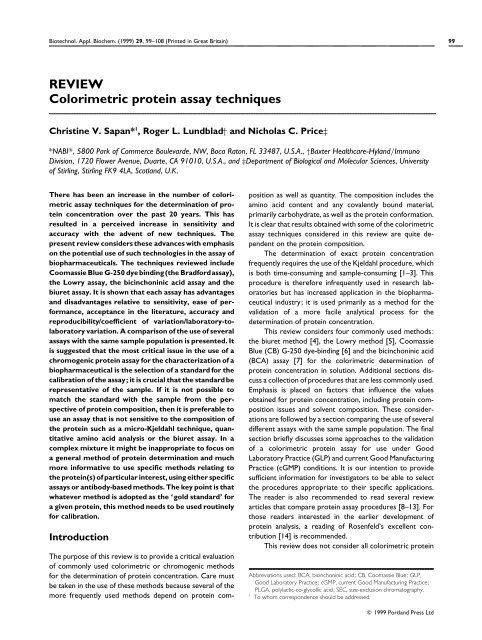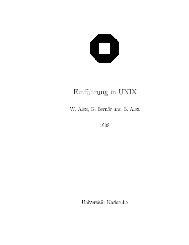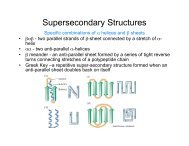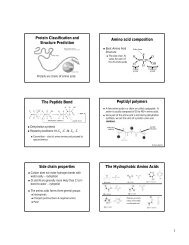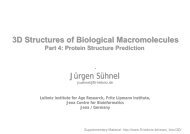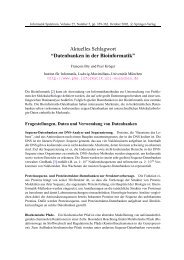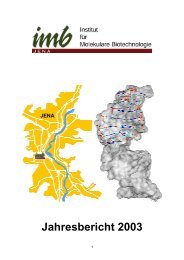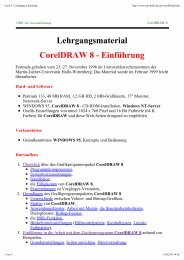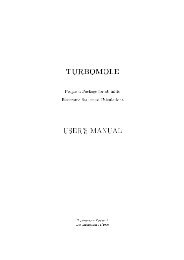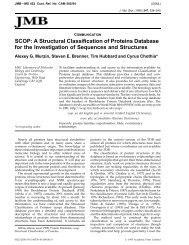REVIEW Colorimetric protein assay techniques - Biotechnology and ...
REVIEW Colorimetric protein assay techniques - Biotechnology and ...
REVIEW Colorimetric protein assay techniques - Biotechnology and ...
Create successful ePaper yourself
Turn your PDF publications into a flip-book with our unique Google optimized e-Paper software.
Biotechnol. Appl. Biochem. (1999) 29, 99–108 (Printed in Great Britain) 99<br />
<strong>REVIEW</strong><br />
<strong>Colorimetric</strong> <strong>protein</strong> <strong>assay</strong> <strong>techniques</strong><br />
Christine V. Sapan* 1 , Roger L. Lundblad† <strong>and</strong> Nicholas C. Price‡<br />
*NABI, 5800 Park of Commerce Boulevarde, NW, Boca Raton, FL 33487, U.S.A., †Baxter Healthcare-Hyl<strong>and</strong>Immuno<br />
Division, 1720 Flower Avenue, Duarte, CA 91010, U.S.A., <strong>and</strong> ‡Department of Biological <strong>and</strong> Molecular Sciences, University<br />
of Stirling, Stirling FK9 4LA, Scotl<strong>and</strong>, U.K.<br />
There has been an increase in the number of colorimetric<br />
<strong>assay</strong> <strong>techniques</strong> for the determination of <strong>protein</strong><br />
concentration over the past 20 years. This has<br />
resulted in a perceived increase in sensitivity <strong>and</strong><br />
accuracy with the advent of new <strong>techniques</strong>. The<br />
present review considers these advances with emphasis<br />
on the potential use of such technologies in the <strong>assay</strong> of<br />
biopharmaceuticals. The <strong>techniques</strong> reviewed include<br />
Coomassie Blue G-250 dye binding (the Bradford<strong>assay</strong>),<br />
the Lowry <strong>assay</strong>, the bicinchoninic acid <strong>assay</strong> <strong>and</strong> the<br />
biuret <strong>assay</strong>. It is shown that each <strong>assay</strong> has advantages<br />
<strong>and</strong> disadvantages relative to sensitivity, ease of performance,<br />
acceptance in the literature, accuracy <strong>and</strong><br />
reproducibility/coefficient of variation/laboratory-tolaboratory<br />
variation. A comparison of the use of several<br />
<strong>assay</strong>s with the same sample population is presented. It<br />
is suggested that the most critical issue in the use of a<br />
chromogenic <strong>protein</strong> <strong>assay</strong> for the characterization of a<br />
biopharmaceutical is the selection of a st<strong>and</strong>ard for the<br />
calibration of the <strong>assay</strong>; it is crucial that the st<strong>and</strong>ardbe<br />
representative of the sample. If it is not possible to<br />
match the st<strong>and</strong>ard with the sample from the perspective<br />
of <strong>protein</strong> composition, then it is preferable to<br />
use an <strong>assay</strong> that is not sensitive to the composition of<br />
the <strong>protein</strong> such as a micro-Kjeldahl technique, quantitative<br />
amino acid analysis or the biuret <strong>assay</strong>. In a<br />
complex mixture it might be inappropriate to focus on<br />
a general method of <strong>protein</strong> determination <strong>and</strong> much<br />
more informative to use specific methods relating to<br />
the <strong>protein</strong>(s) of particular interest, using either specific<br />
<strong>assay</strong>s or antibody-based methods. The key point is that<br />
whatever method is adopted as the ‘gold st<strong>and</strong>ard’ for<br />
a given <strong>protein</strong>, this method needs to be used routinely<br />
for calibration.<br />
Introduction<br />
The purpose of this review is to provide a critical evaluation<br />
of commonly used colorimetric or chromogenic methods<br />
for the determination of <strong>protein</strong> concentration. Care must<br />
be taken in the use of these methods because several of the<br />
more frequently used methods depend on <strong>protein</strong> composition<br />
as well as quantity. The composition includes the<br />
amino acid content <strong>and</strong> any covalently bound material,<br />
primarily carbohydrate, as well as the <strong>protein</strong> conformation.<br />
It is clear that results obtained with some of the colorimetric<br />
<strong>assay</strong> <strong>techniques</strong> considered in this review are quite dependent<br />
on the <strong>protein</strong> composition.<br />
The determination of exact <strong>protein</strong> concentration<br />
frequently requires the use of the Kjeldahl procedure, which<br />
is both time-consuming <strong>and</strong> sample-consuming [1–3]. This<br />
procedure is therefore infrequently used in research laboratories<br />
but has increased application in the biopharmaceutical<br />
industry; it is used primarily as a method for the<br />
validation of a more facile analytical process for the<br />
determination of <strong>protein</strong> concentration.<br />
This review considers four commonly used methods:<br />
the biuret method [4], the Lowry method [5], Coomassie<br />
Blue (CB) G-250 dye-binding [6] <strong>and</strong> the bicinchoninic acid<br />
(BCA) <strong>assay</strong> [7] for the colorimetric determination of<br />
<strong>protein</strong> concentration in solution. Additional sections discuss<br />
a collection of procedures that are less commonly used.<br />
Emphasis is placed on factors that influence the values<br />
obtained for <strong>protein</strong> concentration, including <strong>protein</strong> composition<br />
issues <strong>and</strong> solvent composition. These considerations<br />
are followed by a section comparing the use of several<br />
different <strong>assay</strong>s with the same sample population. The final<br />
section briefly discusses some approaches to the validation<br />
of a colorimetric <strong>protein</strong> <strong>assay</strong> for use under Good<br />
Laboratory Practice (GLP) <strong>and</strong> current Good Manufacturing<br />
Practice (cGMP) conditions. It is our intention to provide<br />
sufficient information for investigators to be able to select<br />
the procedures appropriate to their specific applications.<br />
The reader is also recommended to read several review<br />
articles that compare <strong>protein</strong> <strong>assay</strong> procedures [8–13]. For<br />
those readers interested in the earlier development of<br />
<strong>protein</strong> analysis, a reading of Rosenfeld’s excellent contribution<br />
[14] is recommended.<br />
This review does not consider all colorimetric <strong>protein</strong><br />
Abbreviations used: BCA, bicinchoninic acid; CB, Coomassie Blue; GLP,<br />
Good Laboratory Practice; cGMP, current Good Manufacturing Practice;<br />
PLGA, polylactic-co-glycollic acid; SEC, size-exclusion chromatography.<br />
1 To whom correspondence should be addressed.<br />
1999 Portl<strong>and</strong> Press Ltd
100 C. V. Sapan, R. L. Lundblad <strong>and</strong> N. C. Price<br />
<strong>assay</strong>s. Omitted are 3-(4-carboxybenzoyl)quinoline-2-carboxyaldehyde,<br />
a newly described fluorogenic reagent [15],<br />
reagents such as Bromocresol Green [16] or Albumin Blue<br />
[17], which are used specifically to measure albumin, or<br />
procedures in which the <strong>protein</strong> is derivatized with a ‘signal’<br />
reagent such as biotin, which is subsequently detected by<br />
reaction with peroxidase-coupled avidin [18]. Also not<br />
considered is the use of far-UV spectroscopy [19], the use of<br />
Amido Black [20] or Ponceau S [21] or erythrosin B [22].<br />
Biuret reaction<br />
Although the use of the biuret reaction for the determination<br />
of <strong>protein</strong> concentration dates to 80 years, the current<br />
approaches to the use of this procedure can be traced to the<br />
work of Gornall et al. [4] in 1949. The biuret reaction is<br />
based on the complex formation of cupric ions with <strong>protein</strong>s.<br />
In this reaction, copper sulphate is added to a <strong>protein</strong><br />
solution in strong alkaline solution. A purplish-violet colour<br />
is produced, resulting from complex formation between the<br />
cupric ions <strong>and</strong> the peptide bond. The name of the reaction<br />
is derived from biuret, which forms a similar coloured<br />
complex with cupric ions [23]. The biuret reaction with<br />
<strong>protein</strong>s is independent of the composition of the <strong>protein</strong>;<br />
therefore <strong>protein</strong> composition is not a factor [24–27].<br />
However, <strong>protein</strong> purity <strong>and</strong> association state could influence<br />
the results obtained with the biuret reagent.<br />
The biuret reaction is, however, somewhat insensitive<br />
compared with the other methods of colorimetric <strong>protein</strong><br />
determination. Matsushita et al. [28] have described a recent<br />
modification of the biuret reaction, ‘a reverse biuret<br />
method’, which appears to have significantly increased<br />
sensitivity. Colour in the ‘classic’ biuret reaction is produced<br />
by the formation of a <strong>protein</strong>–copper–tartrate complex; in<br />
the ‘reverse biuret reaction’ colour is generated by the<br />
reduction of excess cupric ions, not bound in the biuret<br />
complex, by ascorbic acid to cuprous ions, which are<br />
subsequently measured as a complex with bathocuproine.<br />
The amount of Cu+–bathocuproine complex is inversely<br />
proportional to the <strong>protein</strong> concentration. The sensitivity of<br />
this reaction is stated to be greater than either the Lowry<br />
<strong>assay</strong> or dye-binding with CB G-250. As with the direct<br />
biuret reaction, there does not appears to be a dependence<br />
on <strong>protein</strong> composition.<br />
Solution constituents such as Tris buffer, ammonium<br />
ions, sucrose, primary amines <strong>and</strong> glycerol can interfere with<br />
the biuret reaction [4]. Potential interference by dextran has<br />
also been described but this appears to be dependent on the<br />
exact method used <strong>and</strong> on instrumentation [29]. Lof et al.<br />
[30] demonstrated a good correlation between the biuret<br />
reaction (3.6 mgml) <strong>and</strong> the Kjeldahl reaction (3.7 mgml)<br />
for highly purified human blood coagulation factor IX. The<br />
biuret method is unsatisfactory for the direct analysis of<br />
urinary <strong>protein</strong> because of the presence of interfering<br />
substances; it is useful after precipitation of the <strong>protein</strong><br />
before analysis [31]. Another report demonstrated a good<br />
correlation between the biuret reaction <strong>and</strong> the Kjeldahl<br />
nitrogen determination in the measurement of <strong>protein</strong> in the<br />
production of yellow-fever vaccine [32]. Reichardt <strong>and</strong><br />
Eckert [33] reviewed the use of the biuret reaction for the<br />
estimation of <strong>protein</strong> in milk, cheese <strong>and</strong> meat. For milk, the<br />
use of KOH <strong>and</strong> a detergent with the biuret reagent provided<br />
satisfactory results. Interference by lactose could be eliminated<br />
by the addition of H 2<br />
O 2<br />
, as could interference by fat or<br />
turbidity. More recently, Cotton et al. [34] have used the<br />
biuret reaction to measure <strong>protein</strong> in cerebrospinal fluid.<br />
It is the experience of one of the present authors that<br />
the biuret method is an accurate method for the determination<br />
of <strong>protein</strong> in solution [11]. This is an experience<br />
shared by other investigators [10,30,35] but it should be<br />
noted that this opinion is not universal [36–38].<br />
The Lowry method<br />
The Lowry method was developed approx. 45 years ago [5].<br />
The name of the method is obtained from the senior author<br />
of this study. The technique was adapted from earlier work<br />
of Wu [39] suggesting the use of the Folin phenol reagent for<br />
the determination of <strong>protein</strong> concentration. The Lowry<br />
reaction is based on the amplification of the biuret reaction<br />
by subsequent reaction with the Folin phenol reagent<br />
(Folin–Ciocalteu reagent [40]). Factors other than the biuret<br />
reaction play a role in the development of colour in the<br />
Lowry method, resulting in considerable variation with<br />
respect to <strong>protein</strong> composition [41–43]. This variation is a<br />
reflection of the contributions of specific amino acids<br />
(tyrosine, tryptophan) on colour development in this reaction<br />
[42,43]. The importance of tyrosine <strong>and</strong> tryptophan in<br />
the Lowry reaction is further demonstrated in studies by<br />
Viner et al. [44] on the oxidative inactivation by sarcoplasmic<br />
reticulum Ca 2 +-ATPase by peroxynitrite. These investigators<br />
observed that oxidation of the <strong>protein</strong> decreased <strong>protein</strong><br />
reactivity in the Lowry reaction. A modification in which the<br />
detection wavelength is 650 nm instead of 750 nm has been<br />
described [45], which reduced <strong>protein</strong> variability. Other<br />
investigators have suggested performing the <strong>assay</strong> at 600 nm<br />
[46]. Various substances interfere with the Lowry reaction,<br />
including many nitrogen-containing buffers [8,9]. A modification<br />
of the Lowry reaction that minimizes such interference<br />
has been reported [47].<br />
As with the biuret reaction, the use of the Lowry<br />
reaction has decreased in recent years as more facile <strong>and</strong><br />
sensitive <strong>protein</strong> <strong>assay</strong>s have become available. However,<br />
there is still substantial use of this technique as evidenced by<br />
1999 Portl<strong>and</strong> Press Ltd
<strong>Colorimetric</strong> <strong>protein</strong> <strong>assay</strong> <strong>techniques</strong> 101<br />
the following citations. The Lowry <strong>assay</strong> has been used by<br />
Williams <strong>and</strong> Halsey [48] to measure <strong>protein</strong> in latex gloves.<br />
Using this technique, <strong>protein</strong> levels ranged from less than 25<br />
to 1150 µgg of glove. Other laboratories have also used the<br />
Lowry method to measure <strong>protein</strong> in latex gloves [49–51].<br />
Dieke <strong>and</strong> Beyer-Mears [52] used the Lowry <strong>assay</strong> to<br />
measure <strong>protein</strong> concentration in cultured lens epithelial<br />
cells. Feldt-Rasmussen et al. [53] used the Lowry <strong>assay</strong> to<br />
determine the <strong>protein</strong> concentration of a purified human<br />
thyroglobulin reference material; this value agreed with the<br />
values obtained by Kjeldahl, UV absorbance <strong>and</strong> amino acid<br />
analysis. Wysocki et al. [54] used the Lowry method to<br />
determine <strong>protein</strong> concentration in fluids from acute <strong>and</strong><br />
chronic wounds <strong>and</strong> serum samples. Alonso <strong>and</strong> Martin-<br />
Mateo [55] have used the Lowry reaction to measure total<br />
<strong>protein</strong> in oyster extracts. Akai et al. [56] used the Lowry<br />
reaction to measure <strong>protein</strong> in cultured mesangial cells.<br />
CB dye-binding <strong>assay</strong> (Bradford <strong>assay</strong>)<br />
The use of the metachromatic response observed on the<br />
binding of CB to <strong>protein</strong>s for the determination of <strong>protein</strong><br />
concentration was popularized by Bradford [6]. The binding<br />
of CB dyes to <strong>protein</strong>s was first studied by Fazekas de St.<br />
Groth et al. [57] in 1963. These investigators presented a<br />
systematic analysis of the use of CB R-250 <strong>and</strong> Procion<br />
Brilliant Blue RS to estimate <strong>protein</strong> concentration on<br />
electrophoretic strips. Both of these dyes were originally<br />
developed for the textile industry. CB is a triphenylmethane<br />
dye belonging to the magenta family. A good correlation was<br />
obtained for the value obtained with a micro-Kjeldahl<br />
procedure <strong>and</strong> CB for albumin <strong>and</strong> rabbit gamma-globulin; a<br />
difference was observed with lysozyme (0.75 compared with<br />
1.16 obtained with the Kjeldahl procedure). Reisner et al.<br />
[58] extended these observations by the use of CB G-250<br />
[59] in perchloric acid to stain gels. The effective use of CB<br />
for the determination of <strong>protein</strong> concentration in solution<br />
required the work of Bradford [6].<br />
The ease <strong>and</strong> high sensitivity of the CB <strong>protein</strong> <strong>assay</strong><br />
have driven its extensive use for the determination of<br />
<strong>protein</strong> concentration in a wide variety of <strong>protein</strong> samples.<br />
The <strong>assay</strong> is based on the binding of the dye to the <strong>protein</strong>(s),<br />
which results in a dye–<strong>protein</strong> complex with increased molar<br />
absorbance. The <strong>assay</strong> is performed at acid pH, at which the<br />
dye is protonated <strong>and</strong> absorbs at 465 nm in solution; on<br />
binding to the <strong>protein</strong>, there is a metachromatic response<br />
with the development of a species absorbing at approx.<br />
595 nm, where the unprotonated species would absorb. The<br />
absorbance maximum of the dye–<strong>protein</strong> complex is a<br />
matter of some debate.<br />
Sedmak <strong>and</strong> Grossberg [60] have reported that the<br />
absorbance maximum of the dye–<strong>protein</strong> complex varied<br />
from 595 to 620 nm depending on the dye source. These<br />
investigators recommended that the ratio of absorbances at<br />
620 <strong>and</strong> 465 nm be used for the quantification of <strong>protein</strong>s.<br />
They also recommended that perchloric acid or hydrochloric<br />
acid be used in place of the phosphoric acid<br />
recommended in the original procedure. Zor <strong>and</strong> Selinger<br />
[61] have suggested that the use of the ratio of the<br />
absorbances at 590 <strong>and</strong> 450 nm improves the linearity of the<br />
CB <strong>assay</strong> system. The use of this ratio also improves the<br />
sensitivity of the <strong>assay</strong> as well as permitting the use of the CB<br />
<strong>assay</strong> in the presence of SDS. Sedmak <strong>and</strong> Grossberg also<br />
demonstrated that peptides with a molecular mass of less<br />
than 3000 Da did not form a complex. It is noted that many<br />
important peptide hormones <strong>and</strong> other bioactive peptides<br />
would fall into this category, thus precluding the use of the<br />
CB <strong>assay</strong> for this class of biopharmaceuticals. Similar results<br />
on the dependence of colour intensity on the molecular<br />
mass of the peptides<strong>protein</strong>s has been reported by de<br />
Moreno et al. [62]. This lack of reaction of CB with peptides<br />
provided the basis for the development of an <strong>assay</strong> for<br />
proteases [58] in which a decrease in the ability of the<br />
substrate, casein, to form a complex with CB absorbing at<br />
595 nm is measured as the index of proteolytic activity.<br />
Since the original description of the dye-binding <strong>protein</strong><br />
<strong>assay</strong>, there have been a number of studies addressing the<br />
mechanism(s) of the CB–<strong>protein</strong> interaction(s). These have<br />
largely been driven by the considerable <strong>protein</strong>-to-<strong>protein</strong><br />
variability as described below. Sedmak <strong>and</strong> Grossberg<br />
suggested that the binding of the dye to <strong>protein</strong> was mediated<br />
by interaction with protonated amino groups on the <strong>protein</strong><br />
[60]. The importance of amino groups on the <strong>protein</strong> has<br />
also been demonstrated by de Moreno et al. [62], suggesting<br />
the importance of the sulphonic acid groups on the dye in the<br />
formation of a ion pair with lysine <strong>and</strong> arginine residues.<br />
Congdon et al. [63] concluded that only lysine <strong>and</strong> arginine<br />
residues are important in the binding of CB. It is of interest<br />
that these investigators did not observe a direct correlation<br />
between dye binding <strong>and</strong> absorption by the bound dye. Chial<br />
<strong>and</strong> Splittgerber [64] also reported the importance of lysine<br />
<strong>and</strong> arginine residues in the binding of CB to <strong>protein</strong>s <strong>and</strong><br />
suggested that only the ionized form of the dye (blue form)<br />
bound to the <strong>protein</strong>. The reaction has been carefully<br />
modelled by Atherton et al. [65], who also concluded that<br />
only the deprotonated (ionized) species of CB bound to the<br />
<strong>protein</strong>, again emphasizing the importance of lysine <strong>and</strong><br />
arginine.<br />
There are other opinions on the mechanism of the<br />
interaction of CB with <strong>protein</strong>s. Tal et al. [66] have examined<br />
the interaction of CB dyes with <strong>protein</strong>s <strong>and</strong> suggested that,<br />
although positive charges on a <strong>protein</strong> are important for the<br />
dye–<strong>protein</strong> interaction, hydrophobic interactions are also<br />
present. These investigators also reported similarities in the<br />
interaction of CB R-250 <strong>and</strong> CB with <strong>protein</strong>s. Fountoulakis<br />
1999 Portl<strong>and</strong> Press Ltd
102 C. V. Sapan, R. L. Lundblad <strong>and</strong> N. C. Price<br />
et al. [67] have also noted the importance of <strong>protein</strong><br />
hydrophobicity in the interaction with CB. These investigators<br />
also demonstrated that <strong>protein</strong> glycosylation interfered<br />
with the reaction with CB.<br />
The above observations on the apparent importance of<br />
basic amino acid residues in the interaction with CB would<br />
suggest that basic <strong>protein</strong>s such as polylysine or lysozyme<br />
would be extremely reactive with CB. This is not the<br />
situation, as reported by several investigators including Van<br />
Kley <strong>and</strong> Hale [68], Pierce <strong>and</strong> Suelter [69] <strong>and</strong> Sedmak <strong>and</strong><br />
Grossberg [60], who all reported a lower colour yield for<br />
lysozyme than for albumin. Experiments reported by Lea et<br />
al. [70,71] further confuse the issue with respect to the<br />
importance of basic amino acid residues in the dye-binding<br />
<strong>assay</strong>. Carbamoylation of lysine resides in BSA or core<br />
histones decreased the absorbance at 595 nm with CB in<br />
ethanolphosphoric acid as described by Bradford [6],<br />
whereas the absorbance at 595 nm observed with H1<br />
histones under the same reaction conditions increased. The<br />
behaviour of polylysine on reaction with sodium cyanate was<br />
unusual because there was initial marked increased in<br />
absorbance at 595 nm followed by a subsequent decrease at<br />
longer reaction times; the pH of the carbamoylation reaction<br />
influenced the subsequent dye–<strong>protein</strong> reaction, with a<br />
greater increase in absorbance at 595 nm with reaction at<br />
pH 6 or in the absence of buffer [70]. These experiments are<br />
consistent with an increase in the metachromasia on the<br />
binding of CB to <strong>protein</strong>s with a decrease in the positive<br />
charge on polylysine. Subsequent studies [71] from the same<br />
laboratory showed that using a higher dye<strong>protein</strong> ratio<br />
decreased the carbamoylation effect <strong>and</strong> gave better colour<br />
yields with the H1 histones. A similar observation has been<br />
reported by Chan et al. [72] with the use of CB for the <strong>assay</strong><br />
of protamines. It has been reported that the CB–<strong>protein</strong><br />
complexes are insoluble at the point of the measurement of<br />
absorbance at 595 nm [73]; this may further contribute to<br />
the <strong>protein</strong>-to-<strong>protein</strong> variation as described below.<br />
The high dependence of the <strong>assay</strong> on <strong>protein</strong> composition<br />
presents a major problem to the broad use of CB<br />
binding as a quantitative <strong>protein</strong> <strong>assay</strong>. It is, however, quite<br />
useful as a general, sensitive, semi-quantitative <strong>assay</strong> for<br />
<strong>protein</strong>s. With the selection of an appropriate st<strong>and</strong>ard, the<br />
<strong>assay</strong> can be both accurate <strong>and</strong> sensitive. Johnson <strong>and</strong> Lott<br />
[74] have used the CB method for the <strong>assay</strong> of <strong>protein</strong><br />
concentration in cerebrospinal fluid by using a st<strong>and</strong>ard of<br />
70% albumin <strong>and</strong> 30% globulin. Pollard et al. [75] have used<br />
CB binding for the estimation of <strong>protein</strong> in adrenal tissue<br />
extracts. An accurate value for the total homogenate<br />
(1.32 mgml) (compared with a trichloroacetic acid precipitation<br />
followed by Lowry determination, 1.34 mgml)<br />
was obtained with BSA as the st<strong>and</strong>ard, whereas a 2-fold<br />
higher value (2.64 mgml) was obtained with gamma-globulin<br />
as the st<strong>and</strong>ard. These two studies emphasize the importance<br />
of the selection of an appropriate st<strong>and</strong>ard for the<br />
reaction.<br />
There have been various attempts to modify the original<br />
CB method to decrease the dependence of absorbance on<br />
<strong>protein</strong> composition. Lea et al. [76] substituted perchloric<br />
acid for phosphoric acid <strong>and</strong> increased the sensitivity for<br />
H1 histone. Reed <strong>and</strong> Northcote reported the decrease in<br />
variability of the response to <strong>protein</strong> composition in the CB<br />
dye-binding <strong>assay</strong> by decreasing the phosphoric acid concentration<br />
or increasing the dye concentration [77]. Protamines<br />
gave a weak reaction with CB under Bradford’s<br />
original conditions; increased reactivity was obtained by<br />
increasing the CB concentration <strong>and</strong> decreasing the concentration<br />
of phosphoric acid [72]. The average number of<br />
dye molecules bound to protamine was estimated as<br />
described by Congdon [63]. There appears to be a ‘threshold’<br />
of binding that must be exceeded to obtain a maximal<br />
response. Stoschek [78] decreased the acidity in the reaction<br />
by the addition of NaOH to decrease the variability in the<br />
chromogenic responses of different <strong>protein</strong>s. Friednauer<br />
<strong>and</strong> Berlet [79] reported that the inclusion of Triton X-100<br />
increased sensitivity <strong>and</strong> decreased <strong>protein</strong>-to-<strong>protein</strong> variability.<br />
Lopez et al. [80] included SDS in the dye-binding <strong>assay</strong><br />
to increase the response of collagen <strong>and</strong> collagen-like<br />
<strong>protein</strong>s. Previously, Wilsott <strong>and</strong> Lott [81] had noted an<br />
improved response of urinary <strong>protein</strong>s in the dye-binding<br />
<strong>assay</strong> with the inclusion of SDS.<br />
Despite the above issues regarding the CB <strong>assay</strong> <strong>and</strong><br />
<strong>protein</strong> composition, this <strong>assay</strong> continues to be used<br />
extensively, reflecting the speed <strong>and</strong> simplicity of this system.<br />
Nakamura et al. [82] have used the CB <strong>assay</strong> to determine<br />
<strong>protein</strong> concentration in culture fluid from rabbit lachrymal<br />
gl<strong>and</strong> slices. Hill <strong>and</strong> MacKessy [83] used the CB <strong>assay</strong> to<br />
determine <strong>protein</strong> concentration in colubrid snake venoms.<br />
Williams et al. [84] developed an automated CB <strong>protein</strong><br />
<strong>assay</strong> for cultured skin fibroblasts by using a r<strong>and</strong>om-access<br />
analyser. Ahmed et al. [85] observed that the interference in<br />
the CB <strong>assay</strong> by vanadyl ribonucleoside <strong>and</strong> orthovanadate<br />
can be eliminated by the inclusion of 0.1% H 2<br />
O 2<br />
in the <strong>assay</strong><br />
prior to the addition of dye reagent. Vanadyl ribonucleoside<br />
<strong>and</strong> orthov<strong>and</strong>ate are frequently used as inhibitors of<br />
ribonuclease <strong>and</strong> <strong>protein</strong> phosphatase activities in tissue<br />
preparations.<br />
BCA <strong>assay</strong><br />
A variation of the Lowry <strong>assay</strong> using BCA was developed by<br />
Smith et al. [7]. This <strong>assay</strong> uses BCA to detect the cuprous<br />
ions generated from cupric ions by reaction with <strong>protein</strong><br />
under alkaline conditions [86]. This <strong>assay</strong> is sensitive <strong>and</strong><br />
relatively easy to perform but still is markedly influenced by<br />
1999 Portl<strong>and</strong> Press Ltd
<strong>Colorimetric</strong> <strong>protein</strong> <strong>assay</strong> <strong>techniques</strong> 103<br />
<strong>protein</strong>-to-<strong>protein</strong> variation [7,11]. In the original study [7],<br />
Smith et al. observed a variation in maximal colour development<br />
as a function of <strong>protein</strong> composition similar to<br />
that observed with the Lowry reaction with the exception of<br />
avidin. The variation as a function of <strong>protein</strong> composition<br />
could be decreased by reaction at 60 C. In studies in which<br />
the BCA reaction was used to measure salivary <strong>protein</strong><br />
concentration [11], values obtained with the BCA reaction<br />
were equal to those observed with the Lowry reaction<br />
(1.08 mgml) but half those measured with the biuret<br />
reaction (2.32 mgml) when BSA was used as the st<strong>and</strong>ard.<br />
The value obtained by quantitative amino acid analysis was<br />
1.95 mgml. Wiechelman et al. [87] showed that cysteine,<br />
cystine, tryptophan, tyrosine <strong>and</strong> the peptide bond are<br />
capable of reducing cupric ions to cuprous ions in the BCA<br />
reaction.<br />
A wide variety of substances can interfere with the BCA<br />
<strong>protein</strong> <strong>assay</strong>. Materials such as EDTA interfere, presumably<br />
by chelating the cupric ions. The presence of glucose results<br />
in artifactually high values unless compensated for with a<br />
reaction blank [7]. Milton <strong>and</strong> Mullen [88] emphasized the<br />
ability of reducing sugars such as fructose <strong>and</strong> lactose to<br />
interfere in the BCA reaction. It should be noted that the<br />
BCA reagent has been used for the direct determination of<br />
reducing sugars [89]. Gupta et al. [90] attempted to use the<br />
BCA reaction to measure <strong>protein</strong> (tetanus toxin) in biodegradable<br />
microspheres but noted that <strong>protein</strong> stabilizers<br />
(glucose, sucrose) interfered with the <strong>assay</strong>. Satisfactory<br />
results were obtained by the use of acid digestion of the<br />
microspheres followed by analysis with the ninhydrin reagent<br />
[91]. Yang <strong>and</strong> Clel<strong>and</strong> [92] studied the release of recombinant<br />
human interferon γ from polylactic-co-glycollic acid<br />
(PLGA) microspheres. These investigators used the BCA<br />
method <strong>and</strong> SDSsize-exclusion chromatography (SDS<br />
SEC) to measure <strong>protein</strong> release from the PLGA microspheres.<br />
Lower values were obtained with the BCA reaction<br />
than with SDSSEC. The authors ascribe this difference to<br />
<strong>protein</strong> aggregation. At 100% monomer there was a good<br />
correlation between the <strong>protein</strong> concentration values obtained<br />
with the BCA reaction <strong>and</strong> SDSSEC; at monomer<br />
concentrations of 20% of less, there was a difference in<br />
concentration of 50% between those determined by the<br />
BCA reaction <strong>and</strong> SDSSEC.<br />
H 2<br />
O 2<br />
has also been reported to interfere with the BCA<br />
<strong>assay</strong> [93]. Phospholipid interferes with the BCA <strong>protein</strong><br />
<strong>assay</strong>, resulting in artifactually high values that reflect the<br />
interaction of phospholipid with the BCA reagent to yield a<br />
chromophore absorbing close to 562 nm [94]. The addition<br />
of 2% (wv) SDS to the BCA <strong>assay</strong> eliminated the interference<br />
by phospholipid [95]. Various zwitterionic buffers<br />
developed by Good et al. [96] interfere with the BCA <strong>assay</strong>,<br />
apparently as a reflection of their ability to bind cupric ions<br />
[97,98]. A technique to avoid interference in the BCA<br />
reaction by solvent has been described by Gates [99]. This<br />
technique utilizes the binding of the <strong>protein</strong> to a positively<br />
charged nylon membrane at pH 8.5. The interfering substances<br />
are then removed by washing followed by reaction<br />
with the BCA reagent.<br />
Biochemical reducing reagents such as dithiothreitol,<br />
glutathione <strong>and</strong> 2-mercaptoethanol interfere with the BCA<br />
reaction by reducing the cupric ions to cuprous ions,<br />
resulting in artifactually high values [100,101]. In one study<br />
[100] the interference was eliminated by the addition of a 10-<br />
fold molar excess (over thiol groups) of iodoacetamide. In<br />
another study [101], the <strong>protein</strong> was precipitated with<br />
deoxycholate <strong>and</strong> trichloroacetic acid prior to <strong>assay</strong> with the<br />
BCA reagent.<br />
Certain detergents can also influence the BCA <strong>assay</strong>.<br />
This is an important consideration as detergents are<br />
frequently used for the isolation of <strong>protein</strong>s <strong>and</strong> some nonionic<br />
detergents such as Tween (polyoxyethylene sorbitan)<br />
derivatives are frequently used in the formulation of some<br />
biopharmaceuticals. As discussed above, the inclusion of<br />
SDS can eliminate the interference by phospholipids.<br />
n-Octanoyl-β-D-glucosylamine has a small effect on the BCA<br />
<strong>protein</strong> <strong>assay</strong>, which could result in a low value; this could be<br />
corrected by the inclusion of the detergent in the reagent<br />
blank [102]. Interference of Tween detergents with the BCA<br />
<strong>protein</strong> <strong>assay</strong> is somewhat more complicated [103]. The<br />
interference of Tween 80 in the BCA <strong>protein</strong> <strong>assay</strong> is<br />
apparently a result of the presence of oxidizing agents. Aged<br />
preparations of Tween had a more marked influence on the<br />
BCA <strong>assay</strong> than did fresh preparations. Tween did not<br />
interfere with the Lowry <strong>assay</strong> but a precipitate occurred at<br />
concentrations greater than 0.2%; the precipitate could be<br />
removed by filtration. Smith et al. [7] reported that Triton<br />
X-100, SDS, Brij 35, Lubrol, CHAPS <strong>and</strong> octyl glucoside did<br />
not markedly influence the <strong>assay</strong> of BSA with the BCA<br />
reaction; all of these compounds caused a precipitate in the<br />
Lowry reaction.<br />
Other substances that interfere with the BCA reaction<br />
with <strong>protein</strong>s include biogenic amines such as catecholamines<br />
[104]. Adrenaline (epinephrine), noradrenaline (norepinephrine)<br />
<strong>and</strong> dopamine demonstrated a linear response<br />
(A 562<br />
) with the BCA reagent. Chlorpromazine, penicillins <strong>and</strong><br />
paracetamol interfered with the BCA reaction in a similar<br />
manner [105]. The mechanism of the interference varied<br />
with the substance. Although all resulted in artifactually high<br />
absorbance values, chlorpromazine produced turbidity that<br />
could not be corrected by a reagent blank, whereas the<br />
penicillins <strong>and</strong> paracetamol produced an immediate increase<br />
in absorbance at 562 nm that was linear <strong>and</strong> could be<br />
corrected by inclusion of the material in the reagent blank.<br />
Anthracycline derivatives also interfered with the BCA<br />
reaction. Kader <strong>and</strong> Liu [106] reported the reduction of<br />
cupric ions to cuprous ions with doxorubicin. As with<br />
1999 Portl<strong>and</strong> Press Ltd
104 C. V. Sapan, R. L. Lundblad <strong>and</strong> N. C. Price<br />
adrenaline <strong>and</strong> noradrenaline as cited above, the interference<br />
is linear <strong>and</strong> the development of absorbance at 562 nm is<br />
immediate, without the time dependence demonstrated by<br />
<strong>protein</strong>s. Doxorubicin did not interfere with the CB<br />
estimation of <strong>protein</strong> concentration.<br />
The BCA–cuprous ion complex is a relatively stable<br />
chromophore absorbing at 562 nm. The development of<br />
colour in the BCA <strong>protein</strong> <strong>assay</strong> is dependent on time,<br />
temperature <strong>and</strong> pH. The <strong>assay</strong> can be performed at room<br />
(ambient) temperature; reaction at 37 C decreases the<br />
time required for maximal colour development, whereas<br />
reaction at 60 C further decreases the time required for<br />
maximal colour development <strong>and</strong> increases sensitivity [7].<br />
The authors strongly encourage investigators to record <strong>and</strong><br />
control, if possible, the actual temperature because room<br />
(ambient) temperature can vary considerably with location.<br />
For GLP <strong>and</strong> cGMP studies, recording <strong>and</strong> validating all<br />
experimental conditions, including temperature, is m<strong>and</strong>atory.<br />
Zhang <strong>and</strong> Halling [107] have suggested that the pH<br />
of the BCA reaction be decreased to 10.7 with a defined<br />
sodium bicarbonatecarbonate buffer, resulting in more<br />
rigorous buffering capacity with only a small effect on colour<br />
development.<br />
BCA has been used for the direct determination of<br />
cuprous ion concentration [86]. The reduction of cupric ions<br />
by <strong>protein</strong>s has also been used for staining <strong>protein</strong> blots<br />
(Western blots) [108,109]. This staining reaction can be<br />
enhanced by silver staining [110]. These investigators have<br />
since applied the silver-enhancement reaction to the detection<br />
of <strong>protein</strong>s adsorbed on microtitre plates [111],<br />
permitting the estimation of as little as 40 ng of <strong>protein</strong>.<br />
Because the BCA <strong>assay</strong> detects cuprous ions generated from<br />
cupric ions by reaction with <strong>protein</strong>, as opposed to the<br />
formation of a chromophore between the reagent <strong>and</strong> the<br />
<strong>protein</strong> such as is observed with CB, this <strong>assay</strong> can be used<br />
to measure <strong>protein</strong> adsorbed or attached on a solid surface<br />
[112]. The study by Root <strong>and</strong> Wang [108] on the silver<br />
enhancement of cupric ion <strong>protein</strong> staining is an example of<br />
this application of the BCA reaction. Tuszynski <strong>and</strong> Murphy<br />
[113] have used the BCA reaction to measure cells adherent<br />
to a microtitre plate. The BCA reaction has also been used<br />
to measure <strong>protein</strong> adsorbed on polymer films intended for<br />
fabrication into intravenous fluid containers [114]. Surfacebound<br />
<strong>protein</strong> determined with the BCA reagent correlated<br />
well with the solution <strong>protein</strong> loss. Potential <strong>protein</strong><br />
therapeutics such as IgG, albumin <strong>and</strong> insulin were evaluated<br />
in this study.<br />
The ability of the BCA reaction to measure insoluble<br />
<strong>protein</strong> permits the development of procedures for the<br />
measurement of very dilute <strong>protein</strong> solutions [115]. This<br />
characteristic of the BCA reaction also permits the determination<br />
of <strong>protein</strong> concentration in solutions complicated<br />
by the presence of other materials such as bile [116].<br />
In both of these studies, the <strong>protein</strong> is precipitated <strong>and</strong> the<br />
subsequent <strong>protein</strong> analysis with the BCA reagent is<br />
performed with the insoluble <strong>protein</strong> precipitate. In the<br />
study with bile, the insoluble precipitate obtained by addition<br />
of acetonitrile to reconstituted freeze-dried bile is washed<br />
with ethanol to remove bile pigments not removed by the<br />
acetonitrile. Wolfe <strong>and</strong> Hay [117] have developed an on-line<br />
<strong>protein</strong> <strong>assay</strong> using BCA reagents. This was used with a flowinjection<br />
analysis to measure antibodies undergoing periodate<br />
oxidation. The effect of temperature was evaluated in<br />
this system; a temperature of 80 C was selected to avoid<br />
bubble formation while obtaining high signal production.<br />
Despite the problems cited above with respect to the<br />
effect of <strong>protein</strong> composition on the quantitative use of the<br />
BCA reaction to determine <strong>protein</strong> concentration, this <strong>assay</strong><br />
system continues to be used for a wide variety of <strong>protein</strong>s.<br />
Keith et al. [118] used the BCA reaction to measure <strong>protein</strong><br />
extracts from contact lenses. A 50:50 mixture of trifluoroacetic<br />
acid <strong>and</strong> acetonitrile was used to the extract the<br />
<strong>protein</strong>s. Zardeneta et al. [119] used the BCA reaction to<br />
determine <strong>protein</strong> concentration in arthrocentesis fluid. Hall<br />
et al. [120] have used the BCA reaction to measure<br />
multidrug-resistance efflux in vitro in cultured cancer cells.<br />
Grealy et al. [121] used the BCA reaction to measure<br />
<strong>protein</strong> in bovine oocytes <strong>and</strong> pre-implantation embryos;<br />
<strong>protein</strong> content correlated well with embryo surface area.<br />
Buija et al. [122] used the BCA reaction to measure <strong>protein</strong><br />
in tissue extracts from middle-ear cholesteatoma; human<br />
skin from the external ear canal was used as a control in this<br />
study. Cingle et al. [123] used the BCA reaction to determine<br />
total <strong>protein</strong> in post-nuclear cell homogenate supernatant<br />
fractions obtained from retinal pigment epithelial cells.<br />
Results obtained from studies with<br />
multiple methods for <strong>protein</strong><br />
determination<br />
As has been emphasized in the sections above, most of the<br />
current colorimetric methods for the determination of<br />
<strong>protein</strong> concentration are dependent on the quality of the<br />
sample. This section discusses studies in which several<br />
methods were employed for the analysis of the sample.<br />
Schlabach [124] compared the biuret reaction <strong>and</strong> the<br />
Lowry reaction for the post-column determination of<br />
<strong>protein</strong>s. With serum as a sample, both the biuret method<br />
<strong>and</strong> the Lowry method could differentiate <strong>protein</strong> from<br />
other material that absorbed light at 254 or 280 nm; the<br />
biuret method was less sensitive than the Lowry method.<br />
Gerbaut <strong>and</strong> Macart [125] compared two turbidimetric<br />
methods <strong>and</strong> two colorimetric methods (biuret <strong>and</strong> Lowry)<br />
for the determination of <strong>protein</strong> concentration in cerebrospinal<br />
fluid by using BSA as the st<strong>and</strong>ard. Values obtained<br />
1999 Portl<strong>and</strong> Press Ltd
<strong>Colorimetric</strong> <strong>protein</strong> <strong>assay</strong> <strong>techniques</strong> 105<br />
with the Lowry method were higher than those obtained<br />
with the CB method in the presence of SDS. Wahl et al.<br />
[126] compared the Lowry <strong>assay</strong>, a modified Lowry (trichloroacetic<br />
acid precipitation of <strong>protein</strong> prior to the Lowry<br />
<strong>assay</strong>) <strong>and</strong> a CB dye-binding <strong>assay</strong> for the measurement of<br />
<strong>protein</strong> in allergen extracts. Values obtained with the<br />
modified Lowry <strong>assay</strong> were less than that obtained with the<br />
st<strong>and</strong>ard <strong>assay</strong>, most probably reflecting the contribution of<br />
non-<strong>protein</strong> material in the allergen extracts to the value<br />
obtained with the st<strong>and</strong>ard <strong>assay</strong>. The dye-binding <strong>assay</strong> gave<br />
a lower value for the allergen extracts with BSA as the<br />
st<strong>and</strong>ard.<br />
In studies with purified <strong>protein</strong>s the dye-binding <strong>assay</strong><br />
gave a higher value than the Lowry <strong>assay</strong> for BSA but a lower<br />
value for ovalbumin. Vik et al. [127] have also studied <strong>protein</strong><br />
<strong>assay</strong> methods by using allergen extracts. Again, the Lowry<br />
<strong>assay</strong> was useful after precipitation of <strong>protein</strong> to remove<br />
non-<strong>protein</strong> material that reacted with the Lowry reagent;<br />
the BCA <strong>assay</strong> also appeared to give excessively high values,<br />
reflecting the influence of non-<strong>protein</strong> material similar to<br />
that observed for the direct Lowry <strong>assay</strong>. The Bradford dyebinding<br />
method appeared to underestimate <strong>protein</strong> (quantitative<br />
amino acid analysis was used as the st<strong>and</strong>ard).<br />
Keller <strong>and</strong> Neville [128] compared the biuret method,<br />
the BCA method, the Lowry method <strong>and</strong> a CB dye-binding<br />
method for the determination of <strong>protein</strong> in human milk. In<br />
these studies, a value for <strong>protein</strong> concentration obtained<br />
with the micro-Kjeldahl method was used as the primary<br />
st<strong>and</strong>ard. The biuret, Lowry <strong>and</strong> BCA methods appeared to<br />
overestimate the <strong>protein</strong> concentration <strong>and</strong> the CB dyebinding<br />
method underestimated <strong>protein</strong> concentration.<br />
Results with purified <strong>protein</strong>s (α-lactalbumin, lactoferrin,<br />
human serum albumin, α-casein <strong>and</strong> IgA) with the four <strong>assay</strong><br />
systems were also reported: lactoferrin consistently gave<br />
the lowest value in all <strong>assay</strong> systems, whereas α-lactalbumin<br />
gave the highest colour value in the biuret <strong>assay</strong>, IgA in the<br />
Lowry <strong>assay</strong> <strong>and</strong> human serum albumin for both the biuret<br />
<strong>and</strong> BCA <strong>assay</strong>s.<br />
Brimer et al. [129] compared the CB dye-binding <strong>and</strong><br />
BCA methods for the <strong>assay</strong> of glycated <strong>protein</strong>s. Incubation<br />
of human serum albumin with glucose resulted in an increase<br />
in A 280<br />
but a decrease in A 595<br />
resulting from CB–<strong>protein</strong><br />
complex formation. Incubation of glucose with albumin<br />
resulted in an increase in apparent <strong>protein</strong> measured by the<br />
BCA reaction. Fountoulakis et al. [67] compared the CB<br />
reaction, the BCA reaction <strong>and</strong> the Lowry method in the<br />
<strong>assay</strong> of non-glycosylated <strong>and</strong> glycosylated <strong>protein</strong>s. For<br />
non-glycosylated <strong>protein</strong>s, the three methods yielded values<br />
consistent with those obtained from quantitative amino acid<br />
analysis. The CB method yielded lower values with glycosylated<br />
<strong>protein</strong>s, whereas both the BCA <strong>and</strong> Lowry methods<br />
gave values higher than that obtained from amino acid<br />
analysis.<br />
In studies of salivary <strong>protein</strong> concencentration [11], the<br />
biuret reaction, the Lowry <strong>assay</strong>, the BCA <strong>assay</strong> <strong>and</strong> CB<br />
<strong>assay</strong> in either the original phosphoric acid formulation [6]<br />
or in the HCl formulation suggested by Sedmak <strong>and</strong><br />
Grossberg [60] were evaluated. With BSA as the st<strong>and</strong>ard,<br />
the biuret <strong>assay</strong> yielded a value of 2.23 mgml, the Lowry<br />
<strong>assay</strong> 1.08 mgml, the BCA 1.08 mgml, dye-binding in HCl<br />
0.94 mgml <strong>and</strong> dye-binding in phosphoric acid 0.96 mgml.<br />
The value obtained by amino acid analysis was 1.95 mgml.<br />
Dawnay et al. [10] reviewed methods used for the determination<br />
of serum <strong>protein</strong> <strong>and</strong> concluded that the biuret<br />
reaction was the only suitable <strong>assay</strong> for the routine<br />
measurement of total serum <strong>protein</strong>. Kirazov et al. [130]<br />
have compared the Lowry <strong>and</strong> Bradford <strong>assay</strong>s for the<br />
determination of <strong>protein</strong> in membrane-containing fractions.<br />
When compared with the Lowry value, none of the<br />
modifications of the original dye-binding <strong>assay</strong> (decreased<br />
acidaddition of NaOH or various detergents including SDS,<br />
CHAPS <strong>and</strong> Triton X-100) were able to increase the values<br />
obtained with the original Bradford procedure [6] compared<br />
with the Lowry <strong>assay</strong>. Lane et al. [131] compared the BCA<br />
<strong>assay</strong> <strong>and</strong> <strong>protein</strong> dye-binding (Bio-Rad). BSA gave the<br />
highest colour value in the dye-binding <strong>assay</strong> (either macroplate<br />
or microplate), whereas α-chymotrypsin <strong>and</strong> gammaglobulin<br />
were equivalent <strong>and</strong> approx. 50–60% of the value<br />
obtained with albumin. α-Chymotrypsin gave the highest<br />
colour value in the BCA <strong>assay</strong>, with albumin <strong>and</strong> gammaglobulin<br />
being equivalent <strong>and</strong> approx. 60–80% of the value<br />
obtained for α-chymotrypsin. The BCA, Lowry <strong>and</strong> CB dyebinding<br />
<strong>assay</strong>s have been compared in the <strong>assay</strong> of <strong>protein</strong><br />
extracted from latex [132]. With BSA as a st<strong>and</strong>ard, the<br />
lowest value was obtained with the dye-binding <strong>assay</strong> with<br />
higher values were obtained with either the BCA <strong>assay</strong> or<br />
the Lowry <strong>assay</strong>. In a study cited above [30], a good<br />
correlation was observed between the Kjeldahl reaction <strong>and</strong><br />
the biuret reaction for purified human blood coagulation<br />
factor IX; lower values were obtained with the CB reagent<br />
<strong>and</strong> UV absorbance. As a result, corresponding values for<br />
biological specific activity varied from 136 i.u.mg (Kjeldahl)<br />
to 200 i.u.mg (CB reagent).<br />
St<strong>and</strong>ards <strong>and</strong> <strong>assay</strong> validation<br />
Any <strong>assay</strong> for <strong>protein</strong> concentration must be validated to<br />
ensure an accurate value for the sample of interest. The<br />
selection of an appropriate st<strong>and</strong>ard is of critical importance<br />
because, with the possible exception of the biuret reaction,<br />
amino acid analysis (ninhydrin reaction) or the Kjeldahl<br />
method, the <strong>protein</strong> <strong>assay</strong>s described above (the CB <strong>assay</strong>,<br />
the BCA method <strong>and</strong> the Lowry reaction) all depend on the<br />
quality of the <strong>protein</strong> for the response. For example, the<br />
value measured for the <strong>protein</strong> concentration of human<br />
1999 Portl<strong>and</strong> Press Ltd
106 C. V. Sapan, R. L. Lundblad <strong>and</strong> N. C. Price<br />
saliva varied from 0.94 mgml (CB <strong>assay</strong>) to 2.23 mgml<br />
(biuret reaction) with BSA as the st<strong>and</strong>ard; if polylysine was<br />
used as the st<strong>and</strong>ard, a value of 65.5 mgml was obtained<br />
with CB dye-binding, whereas the biuret reaction gave a<br />
value of 2.13 mgml. Likewise, the study by Lof et al. [29]<br />
showed that the specific activity (i.u.mg) of a biopharmaceutical<br />
(blood coagulation factor IX) varied significantly<br />
with the <strong>protein</strong> <strong>assay</strong> used.<br />
The selection of an appropriate st<strong>and</strong>ard together with<br />
a rigorous validation of the analytical process can, in<br />
principle, solve the problems presented by the <strong>protein</strong><br />
composition. The validation methodology must include<br />
measurements to ensure that the sample <strong>protein</strong> concentration<br />
is within the dynamic range of the <strong>assay</strong>.<br />
Furthermore all sample types (including in-process <strong>and</strong> final<br />
product) must be independently validated to assess the<br />
effect of <strong>protein</strong> composition as well as interfering or<br />
enhancing substances that may be contained in the sample<br />
including diluent, excipients <strong>and</strong>or stabilizers. As noted<br />
above, these materials have the potential to influence the<br />
measured value markedly.<br />
Reference was made earlier in this review to Good<br />
Laboratory Practice (GLP) <strong>and</strong> current Good Manufacturing<br />
Practice (cGMP). There are terms that the United States<br />
Food <strong>and</strong> Drug Administration (FDA) <strong>and</strong> other regulatory<br />
agencies such as The European Medicines Agencies <strong>and</strong> the<br />
component Committee or Proprietary Medicinal Products<br />
(CPMP) <strong>and</strong> the Committee on Veterinary Medicinal Products<br />
(CVMP) use for regulations that apply to the preclinical<br />
development <strong>and</strong> manufacturing of biopharmaceuticals<br />
[131]. Under these regulations, the laboratory <strong>assay</strong>s are<br />
performed under the oversight of a Quality Assurance<br />
group.<br />
The biopharmaceutical process can be used as a tool to<br />
evaluate the best methodology for <strong>protein</strong> determination.<br />
As the purity <strong>and</strong> sample composition are modified during<br />
processing, the selection of the specific <strong>protein</strong> <strong>assay</strong> is<br />
critical. The intermediate samples may provide answers as to<br />
the best <strong>assay</strong> for even the final product. From initiation to<br />
completion, biopharmaceutical processing maintains goals to<br />
increase product purity <strong>and</strong> specifity. These criteria should<br />
track throughout a robust process <strong>and</strong> if not can provide<br />
clues to <strong>assay</strong> problems or <strong>assay</strong> suitability. In a cGMP<br />
environment, all <strong>assay</strong>s must be validated for all sample<br />
types. The reader is referred to several articles that address<br />
the issue of <strong>assay</strong> validation in greater detail [133–145].<br />
References<br />
1 Young, E. G. (1963) in Comprehensive Biochemistry, vol. 7<br />
(Florkin, M. <strong>and</strong> Stotz, E. H., eds.), pp. 1–55, Elsevier, Amsterdam<br />
2 Henry, P. J. (1964) Clinical Chemistry, Principles <strong>and</strong> Practice,<br />
p.175, Harper <strong>and</strong> Row, New York<br />
3 Minari, O. <strong>and</strong> Zilversmit, D. P. (1963) Anal. Biochem. 6,<br />
320–327<br />
4 Gornall, A. G., Bardawill, C. J. <strong>and</strong> David, M. M. (1949) J. Biol.<br />
Chem. 177, 751–766<br />
5 Lowry, O. H., Rosebrough, N. J., Farr, A. L. <strong>and</strong> R<strong>and</strong>all, R. J.<br />
(1951) J. Biol. Chem. 193, 265–275<br />
6 Bradford, M. M. (1976) Anal. Biochem. 72, 248–254<br />
7 Smith, P. K., Krohn, R. I., Hermansen, G. T., Malia, A. K., Gartner,<br />
F. H., Provenzano, M. D., Fujimoto, E. K., Goeke, N. M., Olson,<br />
B. J. <strong>and</strong> Klenk, D. C. (1985) Anal. Biochem. 150, 76–85<br />
8 Peterson, G. L. (1979) Anal. Biochem. 100, 201–220<br />
9 Peterson, G. L. (1983) Methods Enzymol. 91, 95–119<br />
10 Dawnay, A. B.St.J., Hirst, A. D., Perry, D. E. <strong>and</strong> Chambers, R. E.<br />
(1991) Ann. Clin. Biochem. 28, 556–567<br />
11 Jenzano, J. W., Hogan, S. L., Noyes, C. M., Featherstone, G. L.<br />
<strong>and</strong> Lundblad, R. L. (1986) Anal. Biochem. 159, 370–376<br />
12 Stevens, L. (1992) in Enzyme Assays: A Practical Approach<br />
(Eisenthal, R. <strong>and</strong> Danson, M. J., eds.), pp. 317–335, IRL Press,<br />
Oxford<br />
13 Price, N. C. (1996) in Enzyme LabFax (Engel, P. C., ed.), pp.<br />
34–41, Bios Scientific Publishers, Oxford<br />
14 Rosenfeld, L. (1982) Origins of Clnical Chemistry, Academic<br />
Press, New York<br />
15 You, W. W., Haugl<strong>and</strong>, R. P., Ryan, D. K. <strong>and</strong> Haugl<strong>and</strong>, R. P.<br />
(1997) Anal. Biochem. 244, 277–282<br />
16 Engel, H., Bac, D. J., Brouwer, R., Blijenberg, B. G. <strong>and</strong> Lindemans,<br />
J. (1995) Eur. J. Clin. Chem. Clin. Biochem. 33, 239–242<br />
17 Kessler, M. A., Meinitzer, A. <strong>and</strong> Wolfbeis, O. S. (1997) Anal.<br />
Biochem. 248, 180–182<br />
18 Sulter, M. W., Kloosterhuis, G. J., Coenraads, P. J. <strong>and</strong> Pas, H. H.<br />
(1993) Anal. Biochem. 211, 301–304<br />
19 Wolf, P. (1983) Anal. Biochem. 129, 145–155<br />
20 Goldring, J. P. D. <strong>and</strong> Ravaioli, L. (1996) Anal. Biochem. 242,<br />
197–201<br />
21 Soedjak, H. (1994) Anal. Biochem. 220, 142–148<br />
22 Layne, E. (1957) Methods Enzymol. 3, 447–454<br />
23 Scopes, R. K. (1987) Protein Purification. Principles <strong>and</strong> Practice,<br />
2nd Edn., pp. 279–280, Springer-Verlag, New York<br />
24 Goren, M. P. <strong>and</strong> Li, J. T. L. (1986) Clin. Chem. 32, 386–388<br />
25 Goshev, I. <strong>and</strong> Nedkov, P. (1979) Anal. Biochem. 95, 340–343<br />
26 Doumas, B. T., Bayse, D. D., Carter, R. J., Peters, Jr., T. <strong>and</strong><br />
Schaffer, R. (1981) Clin. Chem. 27, 1642–1650<br />
27 McElderry, L. A., Tarbit, I. F. <strong>and</strong> Cossells-Smith, A. J. (1982)<br />
Clin. Chem. 28, 356–360<br />
28 Matsushita, M., Irino, T., Komoda, T. <strong>and</strong> Sakagishi, Y. (1993)<br />
Clin. Chim. Acta 216, 103–111<br />
29 Barnes, D. B., Pierce, G. F., Lichti, D., L<strong>and</strong>t, M., Koenig, J. <strong>and</strong><br />
Chan, K.-W. (1985) Clin. Chem. 31, 2018–2019<br />
30 Lof, A.-L., Gustafson, G., Novak, V., Engman, L. <strong>and</strong> Mikaelsson,<br />
M. (1992) Vox Sang. 63, 172–177<br />
1999 Portl<strong>and</strong> Press Ltd
<strong>Colorimetric</strong> <strong>protein</strong> <strong>assay</strong> <strong>techniques</strong> 107<br />
31 Eckfeldt, J. H., Kershaw, M. J. <strong>and</strong> Dahl, I. I. (1984) Clin. Chem.<br />
30, 443–446<br />
32 Shrivastaw, K. P., Singh, S., Sharma, S. B. <strong>and</strong> Sokhey, J. (1995)<br />
Biologicals 23, 299–300<br />
33 Reichardt, W. <strong>and</strong> Eckert, W. (1991) Nahrung 35, 731–738<br />
34 Cotton, F., Delobbe, E. <strong>and</strong> Gulbis, B. (1997) Clin. Biochem. 30,<br />
313–314<br />
35 Brooks, S. P. J., Lampi, B. J., Sarwar, G. <strong>and</strong> Botting, H. G. (1995)<br />
Anal. Biochem. 226, 26–30<br />
36 Dilena, B. A., Penberthy, L. A. <strong>and</strong> Fraser, C. G. (1983) Clin.<br />
Chem. 29, 553–557<br />
37 Lim, C. W., Chisnall, W. V., Stokes, Y. M., Debnam, P. M. <strong>and</strong><br />
Crooke, M. J. (1990) Pathology 22, 89–92<br />
38 Borovansky, J., Melezinek, I. <strong>and</strong> Budesninska, A. (1986) Anal.<br />
Biochem. 159, 249–252<br />
39 Wu, H. (1922) J. Biol. Chem. 51, 33–39<br />
40 Folin, O. <strong>and</strong> Ciocalteu, V. (1927) J. Biol. Chem. 73, 627–650<br />
41 Peterson, G. L. (1977) Anal. Biochem. 83, 346–356<br />
42 Chou, S.-C. <strong>and</strong> Goldstein, A. (1960) Biochem. J. 75, 109–115<br />
43 Wu, A. E., Wu, J. C. <strong>and</strong> Herp, A. (1978) Biochem. J. 175, 47–51<br />
44 Viner, R. T., Huhmer, A. F., Bigelow, D. J. <strong>and</strong> Schoneich, C.<br />
(1996) Free Radical Res. 24, 243–259<br />
45 Hartree, E. F. (1972) Anal. Biochem. 48, 422–427<br />
46 Lleu, P. L. <strong>and</strong> Rebel, G. (1991) Anal. Biochem. 192, 215–218<br />
47 Raghupathi, R. N. <strong>and</strong> Diwan, A. M. (1994) Anal. Biochem. 219,<br />
356–359<br />
48 Williams, P. B. <strong>and</strong> Halsey, J. F. (1997) Ann. Allergy Asthma<br />
Immunol. 79, 303–310<br />
49 Heese, A., Lacher, U., Koch, H. U., Kobosch, J., Ghane, Y. <strong>and</strong><br />
Peters, K. P. (1996) Hautarzt. 47, 817–824<br />
50 Beezhold, D., Pugh, B., Liss, G. <strong>and</strong> Sussman, G. (1996) J. Allergy<br />
Clin. Immunol. 98, 1097–1102<br />
51 Beezhold, D., Swanson, M., Zehn, B. D. <strong>and</strong> Kostyal, D. (1996)<br />
Ann. Allergy Asthma Immunol. 76, 520–526<br />
52 Dieck, F. P. <strong>and</strong> Beyer-Mears, A. (1997) Curr. Eye Res. 16,<br />
279–288<br />
53 Feldt-Rasmussen, U., Profilis, C., Colinet, E., Black, E., Bornet, H.,<br />
Bourdoux, P., Coreym, P., Ericcson, U. B., Koutras, D. A., Lamas<br />
de Leon, L. et al. (1996) Annales Biol. Clin. 54, 343–348<br />
54 Wysocki, A. B. (1996) J. Wound Ostomy Contin. Nursing 23,<br />
283–290<br />
55 Alonso, J. I. <strong>and</strong> Martin-Mateo, M. C. (1996) Biol. Trace Element<br />
Res. 53, 85–94<br />
56 Akai, Y., Kusana, E., Amemiya, M., Ono, S., Takeda, S., Hamma,<br />
S. <strong>and</strong> Asano, Y. (1996) Tohoku J. Exp. Med. 178, 137–149<br />
57 Fazekas de St. Groth, S., Webster, R. G. <strong>and</strong> Datyner, A. (1963)<br />
Biochim. Biophys. Acta 71, 377–391<br />
58 Reisner, A. H., Nemes, P. <strong>and</strong> Bucholtz, C. (1975) Anal.<br />
Biochem. 64, 509–516<br />
59 Diezel, W., Kopperschlager, G. <strong>and</strong> Hoffman, E. (1972) Anal.<br />
Biochem. 48, 617–620<br />
60 Sedmak, J. J. <strong>and</strong> Grossberg, S. E. (1977) Anal. Biochem. 79,<br />
544–552<br />
61 Zor, T. <strong>and</strong> Selinger, Z. (1996) Anal. Biochem. 236, 302–308<br />
62 de Moreno, M. R., Smith, J. F. <strong>and</strong> Smith, R. V. (1986) J. Pharm.<br />
Sci. 75, 907–911<br />
63 Congdon, R. W., Muth, G. W. <strong>and</strong> Splittgerber, A. G. (1993)<br />
Anal. Biochem. 213, 407–413<br />
64 Chial, H. J. <strong>and</strong> Splittgerber, A. G. (1993) Anal. Biochem. 213,<br />
362–369<br />
65 Atherton, B. A., Cunningham, E. L. <strong>and</strong> Splittgerber, A. G.<br />
(1996) Anal. Biochem. 233, 160–168<br />
66 Tal, M., Silberstein, A. <strong>and</strong> Nasser, E. (1985) J. Biol. Chem. 260,<br />
9976–9980<br />
67 Fountoulakis, M., Juranville, J. F. <strong>and</strong> Manneberg, M. (1992) J.<br />
Biochem. Biophys. Methods 24, 265–274<br />
68 Van Kley, H. <strong>and</strong> Hale, S. M. (1977) Anal. Biochem. 81, 485–487<br />
69 Pierce, J. <strong>and</strong> Suelter, C. H. (1977) Anal. Biochem. 81, 478–480<br />
70 Lea, M. A., Luke, A., Martinson, C. <strong>and</strong> Velaquez, O. (1986) Int.<br />
J. Pept. Protein Res. 27, 251–260<br />
71 Lea, M. A. <strong>and</strong> Luke, A. (1987) Int. J. Pept. Protein Res. 29,<br />
561–567<br />
72 Chan, J. K., Thompson, J. W. <strong>and</strong> Gill, T. A. (1995) Anal.<br />
Biochem. 226, 191–193<br />
73 Marshall, T. <strong>and</strong> Williams, K. M. (1992) Anal. Biochem. 204,<br />
107–109<br />
74 Johnson, J. A. <strong>and</strong> Lott, H. A. (1978) Clin. Chem. 24, 1931–1933<br />
75 Pollard, H. B., Menard, R., Br<strong>and</strong>t, H. A., Pazoles, C. J., Creutz, C.<br />
E. <strong>and</strong> Ramu, A. (1978) Anal. Biochem. 86, 761–763<br />
76 Lea, M. A., Grasso, S. V., Hu, J. <strong>and</strong> Seidler, N. (1984) Anal.<br />
Biochem. 141, 390–396<br />
77 Reed, S. M. <strong>and</strong> Northcote, D. H. (1981) Anal. Biochem. 116,<br />
53–64<br />
78 Stoschek, C. M. (1990) Anal. Biochem. 184, 111–116<br />
79 Friedenauer, S. <strong>and</strong> Berlet, H. H. (1989) Anal. Biochem. 178,<br />
263–268<br />
80 Lopez, J. M., Valderamme, P. <strong>and</strong> Pavarro, S. (1993) Clin. Chim.<br />
Acta 220, 91–100<br />
81 Wilsott, D. K. <strong>and</strong> Lott, J. A. (1987) Clin. Chem. 33, 2100–2106<br />
82 Nakamura, M., Todo, Y., Akaishi, T. <strong>and</strong> Nakata, K. (1997) Curr.<br />
Eye Res. 16, 614–619<br />
83 Hill, R. E. <strong>and</strong> MacKessy, S. P. (1997) Toxicon 35, 671–678<br />
84 Williams, A. J., Coakley, J. C. <strong>and</strong> Christodoulou, J. (1997) Clin.<br />
Chim. Acta 259, 129–136<br />
85 Ahmed, R. L., Davis, A. T. <strong>and</strong> Ahmed, K. (1996) Anal. Biochem.<br />
237, 76–79<br />
86 Brenner, A. J. <strong>and</strong> Harris, E. D. (1995) Anal. Biochem. 226,<br />
80–84<br />
87 Wiedelman, K. J., Braun, R. D. <strong>and</strong> Fitzpatrick, J. D. (1988) Anal.<br />
Biochem. 175, 231–237<br />
88 Milton, J. D. <strong>and</strong> Mullen, P. J. (1992) Clin. Chim. Acta 208,<br />
141–143<br />
89 Mopper, K. <strong>and</strong> Gindler, E. M. (1973) Anal. Biochem. 56,<br />
440–452<br />
90 Gupta, R. K., Chang, A. C., Griffin, P., Rivera, R., Guo, Y. Y. <strong>and</strong><br />
Siber, G. R. (1997) Vaccine 15, 672–678<br />
1999 Portl<strong>and</strong> Press Ltd
108 C. V. Sapan, R. L. Lundblad <strong>and</strong> N. C. Price<br />
91 Moore, S., Spackman, D. H. <strong>and</strong> Stein, W. H. (1958) Anal.<br />
Chem. 30, 1185–1190<br />
92 Yang, J. <strong>and</strong> Clel<strong>and</strong>, J. F. (1997) J. Pharm. Sci. 86, 908–914<br />
93 Baker, W. L. (1991) Anal. Biochem. 192, 212–214<br />
94 Kessler, R. J. <strong>and</strong> Faneshil, D. D. (1986) Anal. Biochem. 159,<br />
138–142<br />
95 Morton, R. E. <strong>and</strong> Evans, T. A. (1992) Anal. Biochem. 204,<br />
332–334<br />
96 Good, N. E., Winget, G. D., Winter, W., Connolly, T. N.,<br />
Izawa, S. <strong>and</strong> Singh, R. M. M. (1966) Biochemistry 5, 467–477<br />
97 Kaushal, V. <strong>and</strong> Barnes, L. D. (1986) Anal. Biochem. 157,<br />
291–294<br />
98 Lleu, P. L. <strong>and</strong> Rebel, G. (1991) Anal. Biochem. 192, 215–218<br />
99 Gates, R. E. (1991) Anal. Biochem. 196, 290–295<br />
100 Hill, H. D. <strong>and</strong> Straka, J. G. (1988) Anal. Biochem. 170,<br />
203–208<br />
101 Brown, R. E., Jarvis, K. L. <strong>and</strong> Hyl<strong>and</strong>, K. J. (1989) Anal.<br />
Biochem. 180, 136–139<br />
102 Brenner-Henaff, C., Valdor, J.-F., Plusquellec, D. <strong>and</strong> Wroblewski,<br />
H. (1993) Anal. Biochem. 212, 117–127<br />
103 Stutzenberger, F. J. (1992) Anal. Biochem. 207, 249–254<br />
104 Slocum, T. L. <strong>and</strong> Dupree, J. D. (1991) Anal. Biochem. 195,<br />
14–17<br />
105 Marshall, R. <strong>and</strong> Williams, K. H. (1991) Anal. Biochem. 198,<br />
352–354<br />
106 Kader, A. <strong>and</strong> Liu, H. (1997) Clin. Chem. 43, 2201–2202<br />
107 Zhang, J.-X. <strong>and</strong> Halling, P. J. (1990) Anal. Biochem. 188,9–10<br />
108 Root, D. D. <strong>and</strong> Reisler, E. (1989) Anal. Biochem. 181,<br />
250–253<br />
109 Root, D. D. <strong>and</strong> Reisler, E. (1990) Anal. Biochem. 186, 69–73<br />
110 Root, D. D. <strong>and</strong> Wang, K. (1993) Anal. Biochem. 209, 15–19<br />
111 Root, D. D. <strong>and</strong> Wang, K. (1993) Anal. Biochem. 209, 354–359<br />
112 Plant, A. L., Locoscio-Brown, L., Haller, W. <strong>and</strong> Durst, R. A.<br />
(1991) Appl. Biochem. Biotechnol. 30, 83–98<br />
113 Tuszynski, G. P. <strong>and</strong> Murphey, A. (1990) Anal. Biochem. 184,<br />
189–191<br />
114 Rabinow, B. E., Ding, Y. S., Qin, C., McHalsky, M. L., Schneider,<br />
J. H., Ashkine, K. A., Shelbourn, I. L. <strong>and</strong> Albrecht, R. M. (1994)<br />
J. Biomater. Sci. Polymer Ed. 6, 91–109<br />
115 Schoel, B., Welzel, M. <strong>and</strong> Kaufmann, S. H. F. (1995) J.<br />
Biochem. Biophys. Methods 30, 199–206<br />
116 Osnes, T., S<strong>and</strong>stad, O., Skar, V., Osnes, M. <strong>and</strong> Kieruf, D.<br />
(1993) Sc<strong>and</strong>. J. Clin. Lab. Invest. 53, 757–763<br />
117 Wolfe, C. A. <strong>and</strong> Hage, D. S. (1994) Anal. Biochem. 219,<br />
26–31<br />
118 Keith, D., Hong, B. <strong>and</strong> Christensen, M. (1997) Curr. Eye Res.<br />
16, 503–510<br />
119 Zardeneta, G., Milan, S. B. <strong>and</strong> Schmitz, J. P. (1997) J. Oral<br />
Maxillofacial Surg. 55, 709–716<br />
120 Hall, A. M., Cray, V., Chan, T., Ruff, D., Kuczek, T. <strong>and</strong> Chang,<br />
C. (1996) J. Nat. Prod. 59, 35–40<br />
121 Grealy, M., Diskin, M. G. <strong>and</strong> Sreenan, J. M. (1996) J. Reprod.<br />
Fertil. 107, 229–233<br />
122 Buija, J., Kim, C., Ostos, P., Sudhoff, H., Kastenbauer, E. <strong>and</strong><br />
Hultner, L. (1996) Eur. Arch. Oto-Rhino-Laryngol. 253,<br />
252–255<br />
123 Cingle, C. A., Kalski, R. S., Bruner, W. E., O’Brien, C. M., Erhard,<br />
P. <strong>and</strong> Wyczynski, R. E. (1996) Curr. Eye Res. 15, 433–438<br />
124 Schlabach, T. D. (1984) Anal. Biochem. 139, 309–315<br />
125 Gerbaut, L. <strong>and</strong> Macart, M. (1986) Clin. Chem. 32, 353–355<br />
126 Wahl, R., Geissler, W. <strong>and</strong> Maasch, H. J. (1985) Biol. Chem.<br />
Hoppe-Seyler 366, 979–984<br />
127 Vik, H., Holen, E., Dybendal, T. <strong>and</strong> Elsayed, S. (1989) Ann.<br />
Allergy 62, 87–90<br />
128 Keller, R. P. <strong>and</strong> Neville, M. C. (1986) Clin. Chem. 32, 120–123<br />
129 Brimer, C. M., Murray-McIntosh, R. P., Neal, T. J. <strong>and</strong> Davis, P.<br />
F. (1995) Anal. Biochem. 224, 461–463<br />
130 Kirazov, L. P., Venkov, L. G. <strong>and</strong> Kirazov, E. P. (1993) Anal.<br />
Biochem. 208, 44–48<br />
131 Lane, R. D., Federman, D., Flora, J. L. <strong>and</strong> Beck, B. L. (1986) J.<br />
Immunol. Methods 92, 261–270<br />
132 Slatel, J. E. <strong>and</strong> Trybul, D. E. (1994) J. Allergy Clin. Immunol. 93,<br />
825–830<br />
133 Karnes, H. T., Shiu, G. <strong>and</strong> Shah, V. P. (1991) Pharm. Res. 8,<br />
421–426<br />
134 Das, R. E. G. <strong>and</strong> Meager, A. (1995) Biologicals 23, 285–297<br />
135 Bozimowski, D., Artiss, J. D. <strong>and</strong> Zak, B. (1985) J. Clin. Chem.<br />
Clin. Biochem. 23, 683–689<br />
136 Chambers, R. E., Bullock, D. G. <strong>and</strong> Whicher, J. T. (1991) Ann.<br />
Clin. Biochem. 28, 467–473<br />
137 Vogel, P. F. (1993) J. Parenteral Sci. Technol. 47, 276–280<br />
138 Akers, J. (1993) J. Parenteral Sci. Technol. 47, 281–284<br />
139 Irwig, L., Tosteson, A. N. A., Gatsonis, C., Lau, J., Colditz, G.,<br />
Chalmers, T. C. <strong>and</strong> Mosteller, F. (1994) Ann. Internal Med.<br />
120, 667–676<br />
140 Hodgson, J. (1994) Bio/Technology 12, 259–261<br />
141 Albu, M. (1996) Sci. Comput. Automation, May, 29–32<br />
142 McDaniel, R. J. (1996) Sci. Comput. Automation, May, 26–28<br />
143 Doumas, B. T. et al. (1981) Clin. Chem. 27, 1652–1654<br />
144 Zwanziger, H. W. <strong>and</strong> Sa rbu, C. (1998) Anal. Chem. 70,<br />
1277–1280<br />
145 Karnes, H. T. <strong>and</strong> March, C. (1993) Pharm. Res. 10, 1420–1426<br />
Received 16 June 1998; accepted 6 October 1998<br />
1999 Portl<strong>and</strong> Press Ltd


